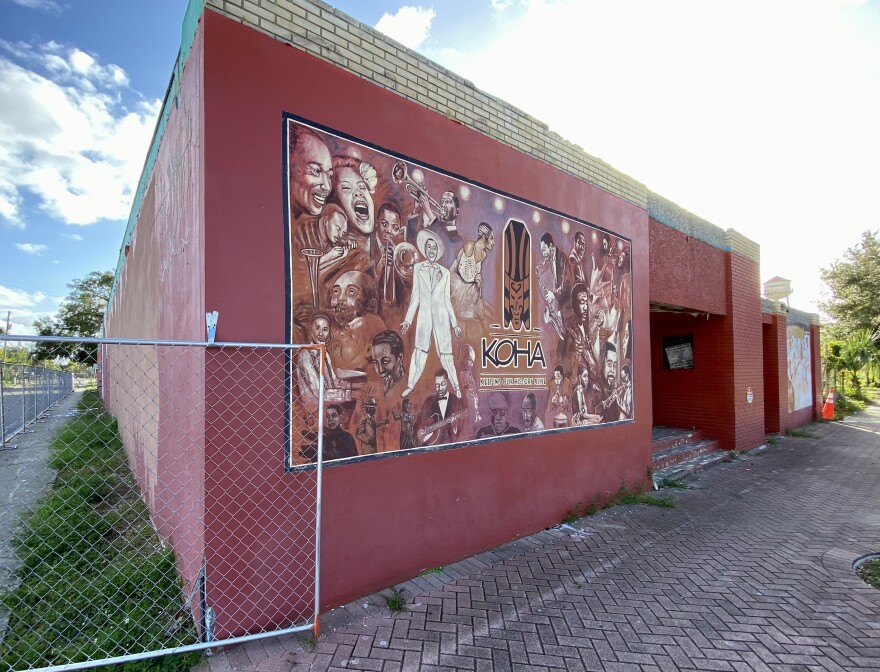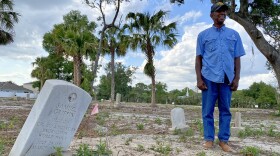The historic town of Eatonville and the current owner of a structure without a roof at 426 E. Kennedy Blvd. are bringing back a treasured piece of Central Florida’s music history: Club Eaton.
The restoration efforts -- funded with the help of a major state grant -- rely in part on the recollections of former patrons, like Jane Turner, who had the opportunity to see James Brown there in the 1963 or '64.

"This was the highlight of my life," she told a small crowd at St. Lawrence AME Church in Eatonville in late October. "I'd heard about James Brown, and of course, he wasn't on the TV, you know, or anything like that, but I'd heard about him. And boy, my goodness, my goodness, it was a treat.”
The group had gathered to share their memories -- and whatever details they could recall about the building itself -- with architect Malcolm Jones, who's handling the restoration.
Club Eaton was a special place, they said, an elegant place. You wore your Sunday best and you felt safe there.
"Being a church girl," 81-year-old Martha Bryant Hall said, "my mother didn't allow us to go to the club, but when I was old enough, all I wanted to do was dance. My mother didn't want us to dance. … And I would dance from the time I got in until about 2.
"I didn't drink and I didn't smoke," she said. "All I wanted to do was dance. And I love dancing today."
Bryant Hall was thrilled to see artists like Brown and Fats Domino and Little Richard, she said. "And tears were just coming out of your eyes because you were so excited, and knowing you have the opportunity to meet these singers."
The Chitlin Circuit
Club Eaton was built by Condor Merritt, a prominent Black businessman, landowner and bolita (or lottery) operator.


Jones, the architect, said it was built in 1946 and opened the next year. It changed ownership a few times over the years. It was expanded, he said, and a second story was added, probably in the 1970s.
The name changed to Mr. B's Club in 1985 and later to Heroes' Night Club and, eventually, Club Koha, which closed in 2008, according to a town webpage.
"It was a super important staple in the town of Eatonville and on what was called the Chitlin Circuit," Jones said.
The Chitlin Circuit was a network of Black-owned venues, where African American artists could perform during the days of segregation.
"These Chitlin Circuit stops, these towns along the way, both urban and rural, were crucial to the careers of a lot of really important artists," said Bob Kealing, a historian and author who writes about music history in Florida.
"One of the cool things I saw in my research that we've been doing on the Chitlin Circuit is in one performance back in about '61," Kealing said, "the bottom of the bill acts were The Miracles, which would included a young Smokey Robinson, and at the very bottom was an act named Gladys Knight & the Pips. So that shows you, right there, how important it was for iconic artists in their early touring days."
For years, Club Eaton was part of that.
"Even after he became famous, his road manager told me that James Brown would often infill larger appearances with gigs at places like Club Eaton," Kealing said. "So it was a well known stop for African American artists, both famous and still working their way up. It had a vital role in Florida's Chitlin Circuit going back, you know, well into the late 40s, the 1950s and the '60s."
A partial demolition
Today the building is a shell of its former self. The roof collapsed and had to be removed and the block walls are supported now by wooden braces.
After Club Koha closed in 2008, the abandoned building gradually fell to pieces.

"If you've seen any movie with zombies in it, unfortunately, it resembled the set of any of those movies," Jones said.
The town of Eatonville and David Barany, the current owner, are working with a $1 million state historic preservation grant to restore the club.
Some funds had to be used for the emergency demolition, including the removal of asbestos. But Jones says the demolition uncovered a row of bricked-in diamond-shaped windows -- which used to be ice glass block windows, typical of Florida nightclubs in the Chitlin Circuit.
Features like that are the kind of historical details the architect is trying to track down through interviews and old photos. Jones also emphasized the importance for restoration purposes of preserving the facade along two sides.

"And our entire job and hope," he said, "is to restore this back to its former glory as much as we possibly can."
Barany said the restored club will be a live music venue and community event center. It will also honor the artists who performed there.
The restored building -- including a large space for events and performances and a second story -- will conform to modern standards, Barany said. "But as far as the overall venue and the ambience … it should be a magical space that takes people back to that particular era."
‘Recreating history’
Eatonville, which was established in 1887, has a unique place in African American history. It was the first all-Black municipality to be incorporated in the United States, according to an article in Reflections, the magazine of the Historical Society of Central Florida.

"And this would be a new addition in a way to our town -- that we are in the process of recreating history in the town of Eatonville," Town Councilwoman Wanda Randolph said.

Club Eaton will bring back "the reality of the historic entertainment during the days of segregation -- and it does have a story, a long, valuable story, as far as African Americans and all of us as people," she said.
Randolph said the club “represents the past of all Black communities that had such an enormous wealth of entertainment that we were trying to create in our own communities.”
Among those who spoke at the church event, Charles McKinney said he would watch shows as a teenager through an exhaust fan in Club Eaton's back wall.
His mother, now 95, worked there as a waitress -- and would do the artists’ hair.
McKinney said the day is coming when people will say: “Look what's here now based on what used to be."
He dreams of showing his mother Club Eaton again when it’s restored.





